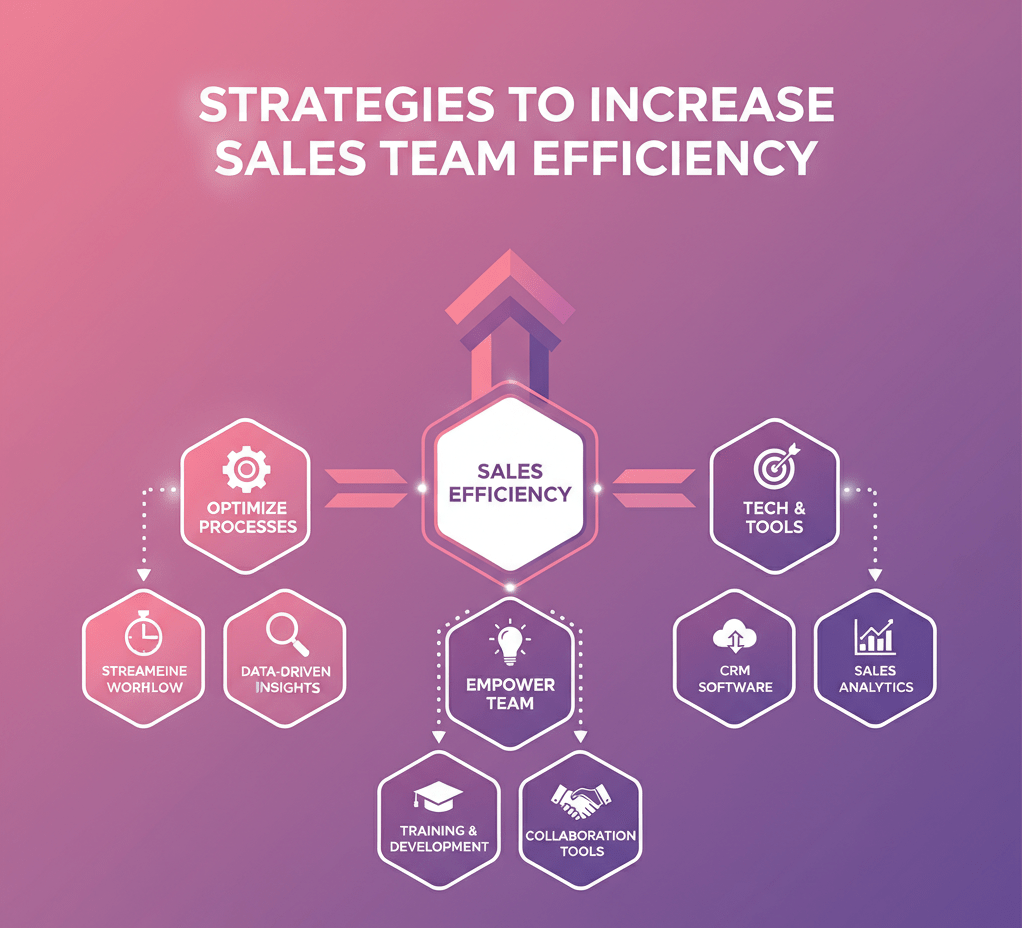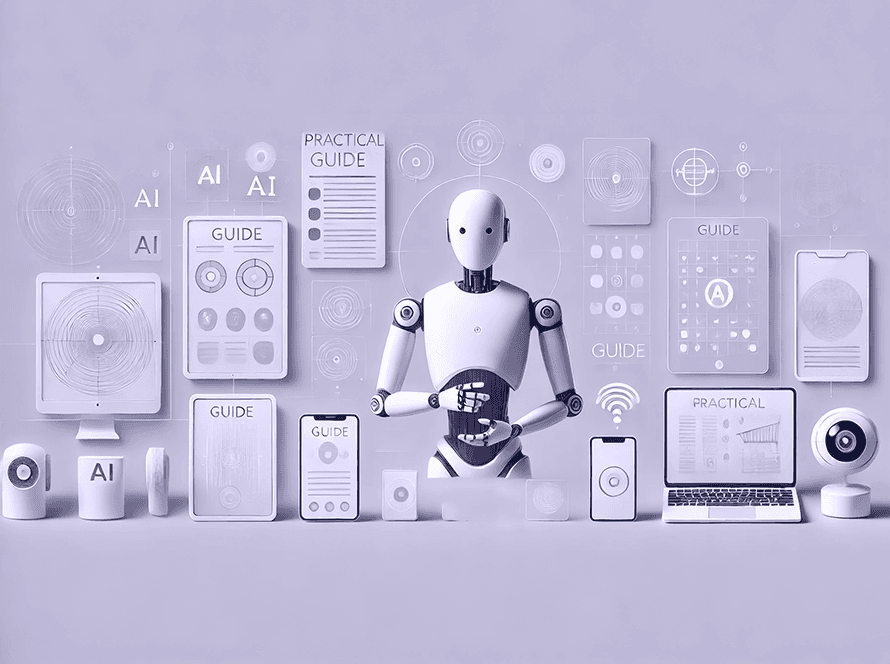“Reclaim 66% of your team’s time by automating lead qualification and follow-ups, using proven Strategies to Increase Sales Team Efficiency.”
Your sales team is your engine for growth. They’re the ones on the front lines, building relationships, demonstrating value, and bringing in revenue. But what if I told you that, on average, they spend less than a third of their time actually selling? It’s a shocking statistic, but study after study confirms it. A recent report from HubSpot, for example, found that sales reps spend only 34% of their time on revenue-generating activities.
So, where does the other 66% go? It gets swallowed by a black hole of administrative tasks: manual data entry, prospecting for hours on end, writing the duplicate follow-up emails repeatedly, and the soul-crushing back-and-forth of trying to schedule a single meeting. These are the non-selling activities that drain your team’s energy, kill their morale, and put a hard ceiling on your company’s growth. Your top performers didn’t get into sales to become expert data-entry clerks. They want to connect with prospects and close deals.
The good news? There’s a powerful solution. Sales automation isn’t about replacing your reps with robots. It’s about empowering your sales representatives by providing them with an arsenal of tools that handle the tedious, repetitive aspects of their job. It’s about giving them back their most valuable asset: time. Time to focus on what they do best—selling.
This guide will outline five powerful and actionable strategies to enhance sales team efficiency through automation. We’ll explore how you can automate everything from initial lead qualification to persistent follow-ups, and we’ll demonstrate how each strategy directly translates into more meetings, a faster sales cycle, and increased revenue. Finally, we’ll introduce an all-in-one platform that brings these strategies together to create a truly unstoppable sales machine.
Strategy 1: Automate Initial Lead Qualification to Focus on Hot Leads
Your team’s time is a finite resource. Every minute a rep spends on a phone call with an unqualified lead is a minute they could have spent moving a real opportunity forward. The traditional approach of handing reps a long list of cold leads and telling them to “start dialing” is one of the biggest drains on sales productivity. It leads to burnout, low conversion rates, and a pipeline filled with dead ends.
The goal isn’t to talk to everyone; it’s to speak to the right people at the right time. This is where automating the initial qualification process becomes a game-changer.
The Problem with Manual Qualification
Manual qualification is incredibly inefficient. A sales development representative (SDR) might spend hours researching a company, identifying the right contact, making a call, and finally getting someone on the phone, only to discover they have no budget, no authority to make a decision, or no immediate need for the solution. This process is not only a massive time sink but also deeply demoralizing. Reps face constant rejection from prospects who were never a good fit in the first place. This is a classic example of working hard, not being brilliant. It’s a surefire way to burn out your best talent and miss your targets.
The Solution: Automated First-Touch Systems
Instead of using your expensive human talent for this top-of-funnel filtering, you can deploy automated systems to do the heavy lifting. These systems act as a 24/7 gatekeeper, engaging with every new lead, asking crucial qualifying questions, and ensuring that only the most promising prospects are passed on to your sales team.
Here’s how you can automate repetitive sales tasks in the qualification stage:
- AI-Powered Website Chatbots: Think of a chatbot not as a simple pop-up, but as a virtual SDR stationed on your website. When a visitor lands on your pricing page, the chatbot can proactively engage them with questions like, “What’s the biggest challenge you’re facing with [your industry problem]?” or “How many users are on your team?” Based on their answers, the bot can determine if they fit your ideal customer profile (ICP). If they do, it can instantly offer to book a meeting with a sales rep. If not, it can guide them to more helpful resources, such as a blog post or a webinar, without requiring a representative’s time.
- Automated Email Nurture Sequences: When a new lead downloads an ebook or signs up for your newsletter, don’t just let them sit in a database. Enroll them in an automated email sequence. The first email can deliver the content they requested. A few days later, a second automated email can ask a targeted qualifying question, such as, “Are you currently using a solution for [problem]?” Their response—or lack thereof—provides valuable data.
- Intelligent Lead Scoring: Lead scoring is the process of assigning points to leads based on their attributes and actions. For example, a lead from a Fortune 500 company might get +10 points. A visit to the pricing page might add another +5 points. Opening a marketing email could be a +1 point. A modern CRM or marketing automation platform can do this automatically. You can set a threshold—say, 50 points—and create a rule that automatically assigns a lead to a sales representative once they reach that score, allowing for immediate follow-up.
The Impact on Efficiency
By automating initial qualification, you fundamentally change the game for your sales team. Reps no longer start their day with a daunting list of cold names. Instead, they log in to find a curated queue of pre-qualified, high-intent leads who have already expressed interest and fit your criteria.
This has a ripple effect on your entire sales process. Speed-to-lead improves dramatically because the system flags hot leads in real-time. The quality of sales conversations goes up because reps are talking to people who actually have the problem you solve. Consequently, conversion rates increase, the sales cycle shortens, and your team’s morale skyrockets. You effectively empower your sales reps by letting them be closers, not just prospectors.
Strategy 2: Eliminate the Back-and-Forth with Automated Appointment Scheduling
One of the most infuriating and unnecessary time-wasters in sales is the “calendar dance.” It looks something like this:
- Rep: “Are you free to connect next week?”
- Prospect: “Sure, how about Tuesday?”
- Rep: “Tuesday works. Does 2 PM EST work for you?”
- Prospect: “Ah, sorry, I have a conflict then. How about 4 PM?”
- Rep: “I’m booked at 4. What about Wednesday morning?”
This email chain can go on for days. Each message is a small, administrative task, but they add up to hours of wasted time across a week. It introduces friction into the sales process at the exact moment you have momentum. It makes your team look disorganized and can even cause hot leads to lose interest and go cold. This is a prime example of a non-selling activity that must be eliminated.
The Problem with Manual Scheduling
Beyond being inefficient, manual scheduling is fraught with risks. A rep might accidentally double-book themselves. Time zone confusion can lead to missed meetings and appointments. The delay in finding a time can give a competitor an opening to swoop in. It’s a low-value task that carries a surprisingly high risk of derailing a potential deal. This is a critical area for improving sales operations.
The Solution: One-Click Scheduling Tools
The solution is stunningly simple: automated scheduling platforms. Tools like Calendly, HubSpot Meetings, SavvyCal, or Chili Piper eliminate the manual effort required for booking appointments.
The process is seamless:
- Set Your Availability: Your sales representative connects their work calendar (e.g., Google Calendar, Outlook 365) to the scheduling tool. They then create rules for their availability, such as only allowing meetings to be booked between 9 AM and 5 PM, adding buffer time between sessions, or preventing last-minute bookings.
- Share a Link: Instead of asking “When are you free?”, the rep simply says, “Here’s a link to my calendar. Feel free to pick a time that works best for you.” This link can be included in their email signature, sent as a direct reply, or embedded on your website after a lead submits a demo request form.
- Prospect Books Instantly: The prospect clicks the link and sees the rep’s real-time availability in their own time zone. They pick a slot, enter their details, and click “confirm.”
- Everything is Automated: The magic happens behind the scenes. The event is instantly and automatically added to both the rep’s and the prospect’s calendars. A calendar invite with all the details (including a video conference link) is sent out. Automated confirmation and reminder emails (and even SMS messages) are scheduled to be sent before the meeting, drastically reducing the likelihood of no-shows.
The Impact on Efficiency
The impact of this one change is profound. You’re not just saving a few minutes per meeting; you’re fundamentally accelerating your sales pipeline.
- Increased Conversion Speed: You can move a lead from initial interest to a booked demo in seconds, not days. This “instant gratification” for the prospect maintains their buying momentum.
- Reduced Administrative Load: Reps can reclaim hundreds of hours per year. This is a perfect example of a sales productivity hack that delivers immediate results. Imagine what your top performer could do with an extra 5-10 hours every month.
- Enhanced Prospect Experience: It’s a smooth, professional, and modern experience for the prospect. You’re showing them that you value their time and are easy to do business with.
- Fewer No-Shows: Automated reminders serve as a personal assistant for every representative, ensuring that prospects remember their commitments. Reducing no-shows directly impacts your team’s output and forecast accuracy.
Implementing automated scheduling is one of the easiest and highest-impact strategies to increase sales team efficiency. It’s a simple change that transforms a major bottleneck into a frictionless pathway.
Strategy 3: Automate Persistent and Personalized Follow-ups
Fortune is in the follow-up. Every sales leader knows this, yet it’s one of the areas where teams struggle the most. Data from Brevet shows that 80% of sales require an average of five follow-ups after the meeting. However, a staggering 44% of salespeople give up after just one follow-up.
Why the disconnect? Because manual follow-up is hard. It’s repetitive, it’s challenging to track, and it requires immense discipline. A rep has dozens of leads at different stages, and trying to remember who needs a follow-up email today, who needs a call tomorrow, and who you haven’t heard from in a week is a recipe for disaster. Leads fall through the cracks, and potential revenue vanishes.
The Problem with Manual Follow-up
Manual follow-up is often inconsistent and generic. A busy rep might send a quick, “Just checking in…” email. This type of low-value message is easily overlooked and does little to advance the deal. Furthermore, when done manually, the process is prone to human error. A rep might forget to follow up entirely or wait too long, allowing a warm lead to go cold. This isn’t a failure of the rep; it’s a failure of the system.
The Solution: Sales Engagement Sequences
Sales engagement platforms (like Outreach, Salesloft, or the sequencing tools within CRMs like HubSpot) are built to solve this exact problem. They allow you to create automated, multi-touch, multi-channel follow-up campaigns that run on autopilot. This is the heart of sales workflow automation.
Here’s how it works:
- Build a Sequence: You design a “sequence” or “cadence,” which is a pre-defined series of steps that will be executed over a period of days or weeks. A typical sequence might look like this:
- Day 1: Automated personalized email.
- Day 3: Automated follow-up email (if no reply).
- Day 5: A manual task is created for the rep to connect with the prospect on LinkedIn.
- Day 7: Another automated email, perhaps with a relevant case study.
- Day 10: A manual task is created for the rep to make a phone call.
- Enroll Prospects: The sales rep can enroll a prospect into a sequence with a single click after a meeting or a call.
- Run on Autopilot: The system takes over. It sends the emails automatically at the scheduled times. It creates tasks in the rep’s queue for manual steps, such as calls or social media interactions.
- Smart Triggers: The automation is intelligent. If a prospect replies to an email or books a meeting, the system automatically removes them from the sequence to prevent awkward, irrelevant follow-ups.
The key here is personalization at scale. Using personalization tokens, each automated email can include the prospect’s name, company, job title, or even custom fields related to their specific pain points. The email that says, “Hi John, following up on our chat about improving [Company Name]’s data security…” feels personal, even though it was sent automatically.
The Impact on Efficiency
Automating follow-ups empowers your team to be persistent without being pests. It ensures that no lead is ever forgotten and that every opportunity is nurtured systematically.
- Guaranteed Persistence: The system never forgets. It ensures that you hit that crucial 5, 6, or even 8-touchpoint mark, dramatically increasing your chances of getting a response.
- Time Management for Sales Teams: Reps no longer have to spend their mornings figuring out who to follow up with. They can focus their energy on the manual tasks created by the system—the phone calls and personalized LinkedIn messages—while the automation handles the email outreach.
- Improved Response Rates: A well-crafted, persistent sequence that provides value at each step (e.g., sharing a blog post, a case study, a helpful tip) will consistently outperform sporadic, generic “checking in” emails.
- Scalability: This system enables a single representative to manage a significantly larger pipeline of opportunities effectively. It’s a direct way to maximize sales output and scale sales without hiring more reps.
By automating follow-ups, you establish a safety net for your entire sales process, capturing leads that would have otherwise been lost due to inaction.
Strategy 4: Centralize Data with Automated CRM Workflows
Your Customer Relationship Management (CRM) system should be your sales team’s single source of truth. It should be the central hub where all prospect interactions, deal information, and pipeline data live. But for many teams, the CRM becomes a dreaded administrative burden. Reps see it as a chore—something they have to update for their manager’s benefit at the end of the day or week.
This leads to a vicious cycle. Because representatives dislike manual data entry, they often do it inconsistently or not at all. The data in the CRM becomes unreliable and outdated. As a result, forecasting is inaccurate, managers can’t effectively coach their team, and the CRM fails to deliver on its promise of providing strategic insights.
The Problem with Manual Data Entry
Manual data entry is the silent killer of sales productivity. Reps spend hours each week logging calls, transcribing notes, updating deal stages, and manually creating follow-up tasks. This is tedious, error-prone work that takes them away from high-value, revenue-generating activities. It’s another prime example of a non-selling activity that technology is ideally suited to handle.
The Solution: CRM Workflow Automation
A modern CRM is more than just a digital rolodex; it’s a powerful automation engine. By setting up automated workflows, you can eliminate the vast majority of manual data entry and create a system that works for your reps, not against them.
Here are some examples of CRM workflows you can implement:
- Automatic Activity Logging: Integrate your team’s email and phone systems with your CRM. Now, every email sent, every call made, and every meeting booked is automatically logged on the contact’s record without the rep ever lifting a finger.
- Deal Stage Automation: Create workflows that trigger automatically when a deal moves from one stage to the next. For example, when a rep moves a deal from “Initial Meeting” to “Proposal Sent,” a workflow can automatically create a task for the rep to follow up in three days and send a notification to the sales manager.
- Lead Rotation and Assignment: When a new qualified lead is received (from your automated qualification system in Strategy 1), a workflow can automatically assign it to the next available representative in a round-robin fashion. This ensures fair distribution and lightning-fast response times.
- Automated Reporting and Dashboards: Stop wasting time manually pulling numbers and building reports. Set up dashboards in your CRM that automatically track your team’s most important KPIs in real-time: pipeline value, win rate, sales cycle length, activity metrics, and more. Managers can see at a glance who is on track and who needs coaching.
The Impact on Efficiency
Automating your CRM transforms it from a glorified spreadsheet into an active, intelligent partner for your sales team.
- Reclaimed Selling Time: This is the most direct benefit. By eliminating hours of data entry per week, you are directly giving that time back to your reps to prospect, demo, and close. This is a significant victory for sales teams in terms of time management.
- Improved Data Quality and Reliability: When data is logged automatically, it’s consistent and accurate. This leads to far more reliable forecasting and a clearer understanding of what works and what doesn’t in your sales process.
- Proactive Sales Management: With real-time dashboards, managers no longer have to chase down reps for updates. They can see what’s happening as it happens, allowing them to provide proactive coaching and support right when it’s needed. This represents a fundamental improvement in sales operations.
- A Seamless Process: Workflows ensure that the baton is never dropped. Tasks are created automatically, notifications are sent, and everyone knows what they need to do next, creating a smooth and efficient journey for every deal in your pipeline.
Strategy 5: Use AI for Sales Enablement and Data-Driven Coaching
The best sales organizations don’t just hire top talent; they create it. They do this through continuous coaching, training, and providing their reps with the right resources at the right time (a practice known as sales enablement). Traditionally, this has been a very manual and often subjective process. A manager might listen in on a few calls or rely on a rep’s self-reported summary of how a deal is progressing.
This approach doesn’t scale. A manager can’t be in every meeting. They don’t have perfect visibility into what separates their top performers from the rest of the team. As a result, coaching can be based on gut feelings rather than data, and new reps can take months to ramp up to full productivity.
The Problem with Traditional Coaching
Without data, coaching is guesswork. A manager might advise a struggling rep to “be more confident” or “ask better questions,” but this feedback isn’t specific or actionable. Furthermore, a company’s best practices are often locked in the heads of its top 1-2 reps. There’s no systematic way to capture their winning talk tracks, objection-handling techniques, and closing language and scale it across the entire team.
The Solution: AI for Sales Enablement
A new generation of AI-powered sales enablement tools is transforming the landscape of sales coaching and training. These platforms utilize artificial intelligence to analyze sales conversations and provide data-driven insights that were previously inaccessible.
Here’s how it works:
- Conversation Intelligence: Platforms like Gong, Chorus, and Fathom connect to your team’s video conferencing and phone systems. They record, transcribe, and analyze every single sales conversation. The AI can then identify key metrics and patterns:
- Talk-to-Listen Ratio: Is your representative talking too much and not allowing the prospect to speak?
- Keyword Tracking: How often are competitors mentioned? How frequently does the rep discuss pricing or key features?
- Question Rate: Are your reps asking enough engaging questions?
- Winning Behaviors: The AI can compare the calls of your top performers against everyone else to identify the specific language and behaviors that lead to closed deals.
- Real-Time Coaching and Content Suggestions: Some tools offer real-time assistance during live calls. If a prospect mentions a competitor, the AI can automatically display a “battle card” on the representative’s screen with key talking points. If a tricky question about pricing arises, it can suggest the best way to address it. It can also recommend the perfect case study or whitepaper to send as a follow-up based on the conversation.
- Creating a “Greatest Hits” Library: Managers can easily clip key moments from calls—a perfect objection handle, a grand discovery call opening, a flawless closing—and build a library of best-practice examples. When a new rep is onboarding, instead of just role-playing, they can listen to dozens of real-world examples of what success sounds like.
The Impact on Efficiency
AI-powered sales enablement acts as a force multiplier for your entire team.
- Faster Onboarding: New reps can ramp up in a fraction of the time by learning directly from the best calls in your organization’s history.
- Data-Driven Coaching: Managers Can Stop Guessing. They can pinpoint the exact skill a rep needs to work on—whether it’s asking more discovery questions or improving their talk-to-listen ratio—and provide targeted, evidence-based feedback.
- Scaling Best Practices: The “secret sauce” of your top performers is no longer a secret. AI allows you to identify what works and systematically train the entire team to replicate that success, lifting the performance of everyone.
- Empowering Your Sales Reps: Reps get immediate, objective feedback on their performance. They have access to the exact content they need, right when they need it. This builds their confidence and makes them more effective in every conversation.

Bringing It All Together: The Ultimate Efficiency with SalesCloser.ai
We’ve covered five powerful strategies to increase sales team efficiency. You can automate lead qualification, streamline appointment scheduling, ensure persistent follow-ups, centralize data in your CRM, and use AI for coaching.
However, implementing these strategies often means stitching together five or more different software tools: a chatbot for your website, a scheduling tool like Calendly, a sales engagement platform like Outreach, your CRM, and a conversation intelligence tool like Gong. This creates a “Frankenstack” of software that can be expensive, difficult to manage, and create data silos where information gets lost between platforms.
What if you could operationalize all five of these strategies with a single, elegant solution? What if you could automate the entire top-of-funnel process with one intelligent agent?
This is where SalesCloser.ai comes in.
SalesCloser.ai isn’t just another tool to help your reps be more efficient. It introduces a new team member: an AI Sales Agent that autonomously handles the most time-consuming, repetitive, and often frustrating parts of the sales development process. It consolidates the functionality of multiple tools into one seamless platform designed to maximize sales output.
Let’s revisit our five strategies and see how SalesCloser.ai executes them flawlessly:
- Automated Lead Qualification: SalesCloser.ai’s AI agent doesn’t just use a chatbot or an email sequence. It picks up the phone and places calls to your new leads. Using advanced conversational AI, it engages prospects in natural, human-like conversations. It asks your custom qualifying questions (using frameworks like BANT, MEDDIC, or your own) to determine if a lead is a good fit. It does the cold calling, so your team doesn’t have to.
- Automated Appointment Scheduling: Once the AI agent qualifies a lead on the call, it doesn’t just send them a link; it also provides a personalized follow-up. It seamlessly transitions the conversation to scheduling. It says, “Based on our chat, it sounds like a demo would be a great next step. I have access to my account executive’s calendar. Are you free Tuesday at 3 PM?” It finds a mutually agreeable time and books the meeting directly on the sales rep’s calendar, right there on the live call. The calendar dance is eliminated.
- Automated Persistent Follow-ups: The AI agent’s job isn’t done after the call. It automatically sends a calendar invitation and a confirmation email to the prospect. It also handles all pre-meeting reminders via email or SMS to dramatically reduce no-shows. If a prospect needs to reschedule, they can interact with the AI to find a new time.
- Automated CRM Data Centralization: Every call, call note, transcript, and outcome is automatically logged in your CRM in real-time. Your data is always up-to-date, without requiring manual entry from your team. This ensures pristine data hygiene and provides a complete record of every interaction.
- AI for Sales Enablement: SalesCloser.ai is the ultimate AI solution for sales enablement. It doesn’t just analyze calls; it handles them. It frees your highly skilled, highly paid human sales reps from the entire top-of-funnel process. This allows them to dedicate 100% of their time and energy to their core competencies: building deep relationships, running fantastic product demonstrations, and closing deals.
SalesCloser.ai is the most direct path to scale sales without hiring. Instead of adding more SDRs to make more calls, you deploy an AI agent that can operate 24/7 with perfect consistency and discipline. You empower your sales reps by giving them what they’ve always wanted: a calendar filled with qualified meetings and the time to focus on what truly matters.
Stop letting your team get bogged down in non-selling activities. It’s time to embrace automation and build a sales process for the future.
Ready to see how an AI Sales Agent can transform your team’s efficiency? Book a Demo of SalesCloser.ai Today!
Frequently Asked Questions (FAQs)
1. What are non-selling activities?
Non-selling activities are tasks that sales representatives perform that do not directly involve interacting with prospects to advance a deal. This includes tasks such as manually entering data into a CRM, attending internal meetings, creating reports, prospecting for leads without outreach, and performing administrative duties, such as scheduling meetings. The goal of sales automation is to minimize or eliminate these tasks.
2. Is sales automation expensive to implement?
The cost of sales automation tools can vary widely, but it’s crucial to think about the return on investment (ROI). While there is a subscription cost, consider the cost of your sales team’s time. If a tool saves each rep five hours a week, that’s 20 hours per month of reclaimed selling time per rep. The increase in productivity and sales output from that recovered time almost always far outweighs the cost of the software. Platforms like SalesCloser.ai consolidate the cost of multiple tools into one, often providing significant cost savings.
3. Will automation replace my sales reps?
No, automation is not about replacing sales reps. It’s about making them better and more efficient. Automation handles the robotic, repetitive tasks that humans aren’t good at and often dislike. This frees up reps to focus on the human elements of selling, including building rapport, understanding complex customer needs, strategic negotiation, and establishing trust. Automation handles the science of sales so your reps can focus on the art.
4. How do I get started with sales workflow automation?
The best way to start is to identify the biggest bottleneck in your current sales process. Is it the time spent on unqualified leads? Is it the back-and-forth of scheduling? Or is it an inconsistent follow-up? Start with one area. Implement a tool to solve that specific problem. For example, start with an automated scheduling tool. Once you see the positive impact, you can move on to automating the next biggest time-waster. This incremental approach makes the transition manageable.
5. What’s the difference between standard sales automation and a platform like SalesCloser.ai?
Standard sales automation tools are designed to help a human sales rep perform a specific task more efficiently. For example, a scheduling tool helps a representative book meetings more efficiently. A sequencing tool helps a rep send follow-up emails more consistently. A platform like SalesCloser.ai is different. It doesn’t just help the human; it takes over the entire process. Its AI agent acts as the sales development rep for the top of the funnel, autonomously performing the calls, qualification, and scheduling. It’s the difference between giving a worker a better hammer and giving them a robotic arm that does the hammering for them.








